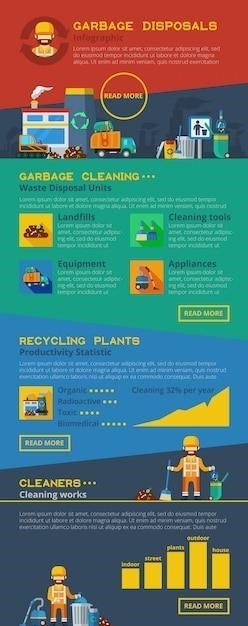RV Furnace Troubleshooting PDF⁚ A Comprehensive Guide
This comprehensive guide will walk you through the process of troubleshooting common RV furnace problems. From basic checks to advanced diagnostics‚ we’ll equip you with the knowledge and steps to identify and fix issues with your RV’s heating system. This PDF guide is designed to help you diagnose and resolve issues with your RV furnace‚ ensuring a warm and comfortable experience on your travels.
Introduction
An RV furnace is an essential component for comfortable travel‚ especially during colder months. It provides warmth and allows you to enjoy your adventures regardless of the weather. However‚ like any appliance‚ RV furnaces can experience issues that require troubleshooting. This guide is designed to empower RV owners with the knowledge and tools to diagnose and resolve common furnace problems.
Whether you’re a seasoned RVer or a first-time camper‚ encountering a malfunctioning furnace can be frustrating. Understanding the basic workings of your RV furnace and familiarizing yourself with potential issues can save you time‚ money‚ and stress. This guide will cover a range of troubleshooting steps‚ from checking the power supply to examining the flame sensor.
By following the outlined steps and utilizing the provided troubleshooting flowchart‚ you’ll be able to identify the root cause of your furnace problems and implement appropriate solutions. Remember‚ safety is paramount when working with any appliance‚ so always prioritize your well-being and follow all safety precautions outlined in this guide.
Common RV Furnace Problems
RV furnaces are generally reliable‚ but like any appliance‚ they can experience problems. Recognizing common issues can help you diagnose the problem and find a solution.
Here are some of the most frequent RV furnace problems⁚
- No Ignition⁚ The furnace doesn’t start or ignite‚ leaving you with cold air. This could be due to a faulty power supply‚ thermostat‚ flame sensor‚ or gas supply.
- Blowing Cold Air⁚ The furnace runs‚ but it only produces cool air. This could indicate a problem with the burner‚ the vent‚ or a blockage in the airflow.
- Intermittent Operation⁚ The furnace turns on and off randomly‚ or it may not stay lit consistently. This could be caused by a faulty thermostat‚ a clogged vent‚ or a problem with the control board.
- Loud Noises⁚ The furnace makes unusual noises‚ such as rattling or banging. This could indicate a loose component‚ a worn-out fan‚ or a problem with the burner.
- Incomplete Combustion⁚ The furnace produces soot or smoke‚ indicating incomplete burning of the fuel. This could be due to a dirty burner‚ a blocked vent‚ or a problem with the gas supply.
By understanding these common problems‚ you can begin to pinpoint the potential cause of your furnace malfunction and proceed with the appropriate troubleshooting steps.

Troubleshooting Steps
Before embarking on any troubleshooting‚ ensure you have the necessary safety equipment‚ such as a multimeter and a gas leak detector. It is always a good idea to consult your RV’s owner’s manual for specific instructions and warnings related to your furnace model.
Here’s a step-by-step approach to troubleshooting common RV furnace problems⁚
- Check the Power Supply⁚ Make sure the furnace is receiving power. Check the circuit breaker or fuse that controls the furnace. If the circuit breaker is tripped or the fuse is blown‚ reset or replace it.
- Inspect the Thermostat⁚ Ensure the thermostat is set to the desired temperature and is functioning properly. Check the thermostat’s batteries if it’s battery-operated. Also‚ verify that the thermostat is properly connected to the furnace.
- Examine the Flame Sensor⁚ The flame sensor is a safety device that detects the presence of a flame. If the flame sensor is dirty or faulty‚ the furnace might not ignite properly. Clean the sensor with a fine-grit sandpaper or replace it if necessary.
- Verify the Gas Supply⁚ Ensure the propane tank is full and the gas valve to the furnace is open. Check for leaks using a gas leak detector. If you suspect a leak‚ immediately turn off the gas supply and contact a qualified technician.
These initial troubleshooting steps can help you identify and resolve a significant number of RV furnace problems.
Check the Power Supply
A common reason for an RV furnace not to work is a lack of power. The furnace relies on a 12-volt DC power supply‚ typically from your RV’s battery. Before you start troubleshooting more complex issues‚ ensure the furnace is receiving power.
Here’s how to check the power supply⁚
- Locate the Furnace’s Fuse or Circuit Breaker⁚ The fuse or circuit breaker for the furnace is usually located in the RV’s electrical panel. It may be labeled “Furnace” or have a symbol that resembles a heater.
- Inspect the Fuse or Circuit Breaker⁚ Check if the fuse is blown or the circuit breaker is tripped. A blown fuse will have a broken filament‚ while a tripped circuit breaker will be in the “off” position.
- Reset or Replace the Fuse or Circuit Breaker⁚ If the fuse is blown‚ replace it with a fuse of the same amperage. If the circuit breaker is tripped‚ reset it by flipping the switch to the “on” position.
- Check the Battery⁚ If the fuse or circuit breaker is fine‚ check the RV’s battery. Ensure it is charged and connected properly. A weak or dead battery can cause power issues for the furnace.
If you’ve checked the power supply and everything seems to be working‚ move on to the next troubleshooting steps.
Inspect the Thermostat
The thermostat is the brain of your RV furnace‚ controlling the temperature inside your RV. If the thermostat is malfunctioning‚ the furnace won’t turn on or might not reach the desired temperature. Here’s how to inspect the thermostat⁚
- Check the Thermostat’s Settings⁚ Ensure the thermostat is set to “heat” and the temperature is set to a level higher than the current room temperature. The thermostat should be turned on and the fan should be set to “auto.”
- Test the Thermostat⁚ Turn the thermostat up a few degrees. If the furnace fan starts running‚ the thermostat is likely working. If the fan doesn’t turn on‚ the thermostat might be faulty.
- Check for Loose Connections⁚ Inspect the thermostat’s wiring connections for any loose or corroded wires. Tighten any loose connections and clean any corrosion.
- Replace the Thermostat⁚ If the thermostat is still not working‚ it might be faulty and need to be replaced. Make sure to purchase a thermostat compatible with your RV furnace model.

If the thermostat is working correctly‚ the problem might lie with the furnace itself. Move on to the next troubleshooting step to investigate further.
Examine the Flame Sensor
The flame sensor is a crucial component of your RV furnace that detects the presence of a flame. If the flame sensor is dirty‚ malfunctioning‚ or not properly positioned‚ the furnace may not ignite or may shut off prematurely. Here’s how to examine the flame sensor⁚
- Locate the Flame Sensor⁚ The flame sensor is typically a small metal rod located near the burner. It’s often connected to a wire that runs to the control board.
- Clean the Flame Sensor⁚ Carefully remove the flame sensor from the furnace. Clean it with a fine-grit sandpaper or a wire brush to remove any dirt or debris. Be cautious not to damage the sensor during cleaning.
- Inspect for Damage⁚ Examine the flame sensor for any signs of damage‚ such as bending‚ cracks‚ or corrosion; If the sensor is damaged‚ it needs to be replaced.
- Check the Flame Sensor’s Position⁚ Ensure the flame sensor is properly positioned within the burner area. It should be positioned so that the flame touches the sensor without obstruction;
- Test the Flame Sensor⁚ If the flame sensor is clean‚ undamaged‚ and positioned correctly‚ try turning on the furnace. If the flame sensor is working properly‚ the furnace should ignite. If the furnace still fails to ignite‚ the flame sensor may still be faulty and need replacement.
If the flame sensor is working correctly‚ move on to the next troubleshooting step to check other potential issues.
Verify the Gas Supply
A consistent and adequate gas supply is essential for your RV furnace to operate correctly. If the gas supply is interrupted or insufficient‚ the furnace may not ignite or may shut down unexpectedly. To verify the gas supply‚ follow these steps⁚
- Check the Propane Tank⁚ Ensure your propane tank is full. You can gauge the level by looking at the gauge on the tank or by using a propane tank gauge. If the tank is low‚ refill it before proceeding.
- Inspect the Propane Lines⁚ Examine the propane lines leading to your furnace for any signs of leaks‚ cracks‚ or damage. Look for any signs of propane odor‚ hissing sounds‚ or moisture around the lines.
- Open the Propane Valve⁚ Make sure the propane valve at the tank is fully open. Verify that the valve handle is turned completely counterclockwise.
- Check the Furnace’s Gas Valve⁚ Locate the manual shut-off valve on the furnace. This valve is usually found on the side of the furnace and may have a lever or a knob. Ensure the valve is fully open.
- Test the Gas Supply⁚ To confirm the gas supply is reaching the furnace‚ try turning on the furnace. If you hear a hissing sound or smell propane gas‚ it’s a sign that the gas is flowing. If you don’t hear or smell anything‚ there may be a blockage in the gas line.
If you suspect a gas leak‚ immediately turn off the propane valve and contact a qualified RV technician to inspect and repair the leak. Never attempt to repair a gas leak yourself.
Advanced Troubleshooting
If you’ve gone through the basic troubleshooting steps and your RV furnace still isn’t working‚ you may need to delve into more advanced diagnostics. These issues often require a deeper understanding of your furnace’s components and may necessitate the assistance of a qualified RV technician. Here are some common advanced troubleshooting scenarios⁚
- Sail Switch⁚ The sail switch is a safety device that prevents the furnace from igniting if the blower fan isn’t running. If the sail switch is faulty‚ it can prevent the furnace from starting. You can test the sail switch by using a jumper wire to bypass it. If the furnace ignites‚ you’ll need to replace the sail switch.
- Control Board⁚ The control board is the “brain” of your RV furnace‚ controlling its operation. A faulty control board can cause a variety of problems‚ including failure to ignite‚ intermittent operation‚ or complete shutdown. Replacing the control board requires specialized knowledge and tools.
- High Altitude Issues⁚ Some RV furnaces struggle to operate efficiently at high altitudes. The reduced air pressure at higher elevations can affect the combustion process. If your furnace is experiencing problems at high altitudes‚ you may need to consider a furnace replacement or consult with a technician for possible adjustments.
Remember‚ if you’re not comfortable with advanced troubleshooting‚ it’s best to consult with a qualified RV technician. They have the expertise and tools to diagnose and repair complex issues with your RV furnace.
Sail Switch
The sail switch is a critical safety component in your RV furnace that ensures the blower fan is running before the furnace ignites. This prevents the furnace from overheating due to a lack of airflow. If the sail switch malfunctions‚ it can prevent your furnace from starting. Here’s how to troubleshoot a sail switch issue⁚
- Check the sail switch for signs of damage or debris⁚ Inspect the switch for any visible damage‚ corrosion‚ or obstructions that might be hindering its operation.
- Test the sail switch using a jumper wire⁚ Disconnect the sail switch wires from the furnace. Connect the wires together using a jumper wire (like a paperclip). Turn on the furnace. If the furnace ignites‚ it indicates a faulty sail switch that needs replacement.
- Replace the sail switch⁚ If the sail switch is faulty‚ replace it with a new one. Consult your RV furnace’s manual for specific instructions on replacing the sail switch.
Remember‚ never attempt to bypass the sail switch permanently. It’s a vital safety device that should be functioning correctly to prevent potential hazards.
Control Board
The control board is the brains of your RV furnace‚ managing the entire heating process. If the control board malfunctions‚ it can cause a range of problems‚ including the furnace not starting‚ inconsistent heating‚ or erratic behavior. Here’s how to diagnose a control board issue⁚
- Check for power⁚ Ensure the control board is receiving power by checking the fuse or circuit breaker. If the fuse is blown or the circuit breaker is tripped‚ replace or reset it accordingly.
- Inspect the control board⁚ Visually inspect the control board for any signs of damage‚ corrosion‚ or loose connections. If you spot any issues‚ consult your RV furnace manual for specific instructions on replacing the control board.
- Test the control board with a multimeter⁚ If you have a multimeter‚ you can test the control board’s various components to see if they are functioning properly. Consult your RV furnace manual or an online troubleshooting guide for specific instructions on testing the control board.
- Replace the control board⁚ If the control board is faulty‚ replace it with a new one. Be sure to purchase a control board specifically designed for your RV furnace model.
Remember‚ working with electrical components requires caution. If you’re unsure about any steps‚ it’s best to seek assistance from a qualified RV technician.
High Altitude Issues
RV furnaces can struggle to operate efficiently at higher altitudes due to the thinner air and lower atmospheric pressure. This can lead to issues like incomplete combustion‚ poor flame ignition‚ and reduced heating output. Here’s how to troubleshoot high altitude problems⁚
- Adjust the air intake⁚ Some RV furnaces have adjustable air intake vents. Try opening the air intake vent slightly to allow more air into the combustion chamber‚ which can help compensate for the thinner air at higher altitudes.
- Check the flame sensor⁚ The flame sensor is a crucial component in the ignition process. At higher altitudes‚ the flame may be weaker‚ potentially causing the flame sensor to malfunction. Clean the flame sensor or replace it if necessary.
- Consider a high-altitude furnace⁚ If your RV furnace consistently struggles at high altitudes‚ you may need to consider investing in a furnace specifically designed for higher elevations. These furnaces have adjustments or modifications that allow them to operate more efficiently in thinner air.
- Contact a professional⁚ If you’re unsure about troubleshooting high altitude problems‚ it’s best to contact a qualified RV technician. They can diagnose the issue and recommend the appropriate solution.
Remember‚ it’s essential to consult your RV furnace manual for specific instructions and safety precautions related to high altitude operation.
